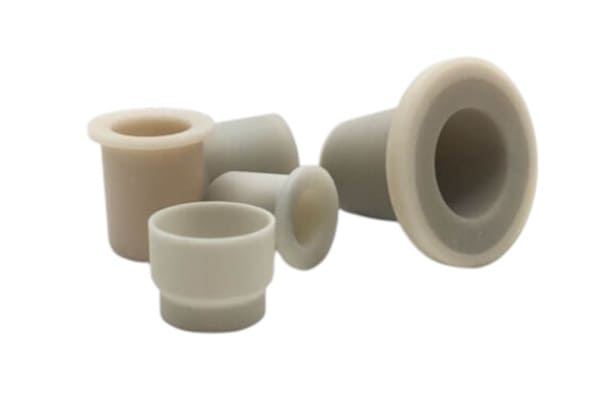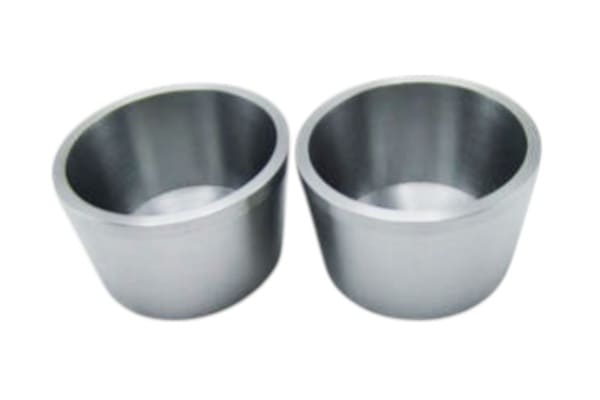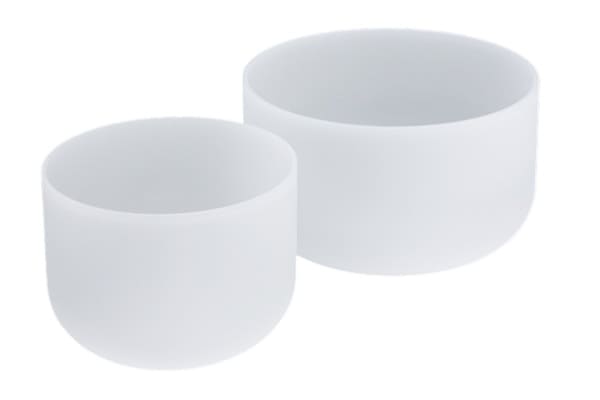Crucibles are an essential piece of equipment used across a wide range of industries, primarily for holding materials at high temperatures, especially during melting, heating, or chemical reactions. In industries such as metalworking, chemistry, and glassmaking, crucibles serve as a vessel for safely withstanding extreme heat without breaking down or contaminating the contents. The significance of crucibles lies in their ability to resist thermal shock, chemical corrosion, and mechanical stress during high-temperature processes.
The article aims to provide a comprehensive guide to the different types of crucibles available in the market, their material properties, uses, and the factors you should consider when selecting the right one for your needs.
At Heeger Materials Inc., we specialize in high-quality crucible products made from a variety of materials and specifications, ensuring optimal performance for industrial and scientific applications.
What is a Crucible?
A crucible is a container designed to hold materials at extremely high temperatures, often for melting, refining, or analyzing substances. Typically cup-shaped, crucibles are made from materials that resist thermal shock, chemical corrosion, and physical degradation. Their primary function is to contain substances—such as metals, alloys, or chemicals—during processes like melting, calcination, or crystal growth, ensuring the material remains uncontaminated and the container itself does not fail under stress.
Historically, crucibles have been used for thousands of years, dating back to ancient civilizations that employed clay crucibles for metalworking. Over time, advancements in materials science have led to the development of crucibles made from ceramics, graphite, silica, and metals, each suited to specific applications. Today, crucibles are found in diverse fields, from small-scale laboratory experiments to large-scale industrial processes. Their evolution reflects humanity’s growing need for precision and durability in high-temperature environments.
Looking for high-quality crucible products? Explore Heeger Materials’ Selection.
Common Materials Used in Crucibles
Crucibles are crafted from a variety of materials, each with unique properties that make them suitable for specific applications.
Ceramic Crucibles

Material | Max Temp (°C) | Thermal Shock Resistance | Chemical Resistance | Typical Applications |
1700-1900 | Moderate | Excellent (acid/base resistance) | High-purity metal melting (e.g., Pt, Pd), glass processing, semiconductor synthesis. | |
2200-2400 | Low | Excellent (inert to molten metals) | Superalloy melting, reactive metal handling (Ti, Zr), advanced ceramics. | |
2000-2200 | Low | Poor (reacts with acids) | Steel/iron alloy processing, nickel-based superalloys. | |
2500-3000 | High (inert atm) | Good (oxidizes in air) | Non-oxide metal casting (e.g., Cu, Al), vacuum furnaces, carbide synthesis. | |
2000-2500 | Very High | Excellent (inert to most melts) | Semiconductor crucibles, high-purity metal handling, aerospace materials. | |
Mullite (3Al₂O₃·2SiO₂) | 1500-1700 | High | Good (moderate corrosion resistance) | General-purpose lab crucibles, glass/ceramic sintering, intermediate-temperature uses. |
Metal Crucibles

Material | Max Temp (°C) | Thermal Conductivity | Chemical Resistance | Oxidation Resistance | Typical Applications |
1600-1800 | High | Exceptional (resists acids, molten salts) | Excellent | High-purity melts (e.g., glass, rare earth metals), lab research. | |
Nickel (Ni) | 1200-1450 | Moderate-High | Good (alkalis), poor with acids | Moderate (oxidizes) | Alkali fluxes, sodium-based reactions, alloy testing. |
2000-2600 | High | Resists molten metals (e.g., Cu, Ag) | Poor (requires H₂/vacuum) | High-temp alloys, vacuum furnaces, sapphire growth. | |
3000+ | Very High | Inert to most non-oxidizing melts | Poor (needs inert gas) | Ultra-high-temp applications (e.g., laser sintering, rocket materials). | |
2500-3000 | Moderate | Excellent (HF, corrosive salts) | Poor (oxidizes in air) | Corrosive environments (e.g., Ta/Nb refining), chemical reactors. | |
Stainless Steel (SS) | 1000-1200 | Low-Moderate | Moderate (weak vs. chlorides/acid) | Moderate | Low-cost lab use, non-reactive melts (e.g., lead, tin). |
Graphite-Coated Steel | ~1200 | High (coating-dependent) | Improved slag resistance | Moderate (coating helps) | Foundry applications (e.g., Zn, Al casting). |
Quartz (Silica) Crucibles

Property | Description |
Material | Fused Quartz (SiO₂), high-purity amorphous silica. |
Max Temperature | Short-term: 1100–1300°C (softens at ~1670°C) |
Thermal Shock Resistance | Excellent – Can withstand rapid temperature changes (e.g., water quenching). |
Chemical Resistance | Good against acids (except HF), halogens, and water. |
Thermal Conductivity | Low (~1.4 W/m·K), heats evenly but slowly. |
Optical Properties | Transparent to UV/visible/infrared light (useful for optical applications). |
Mechanical Strength | Brittle; susceptible to mechanical impact. |
Typical Applications:
- Semiconductor: Czochralski (CZ) silicon crystal growth.
- Metallurgy: Melting noble metals (Au, Ag).
- Chemistry: Acid digestions, high-purity reactions.
- Optics: UV lamp housings, laser components.
- Laboratory: General-purpose high-temp crucibles.
Explore our optimized crucible products.
Advantages and Limitations of Different Crucible Types
1. Ceramic (Alumina, Zirconia) Crucibles
Advantages:
- High purity, ideal for lab use and high-precision applications.
- Resistant to oxidation and corrosive environments.
- Can withstand very high temperatures (Alumina: ~1800°C, Zirconia: ~2400°C).
Limitations:
- Poor thermal shock resistance (can crack with rapid heating/cooling).
- Lower thermal conductivity than graphite or SiC.
- Brittle and prone to mechanical damage.
2. Metal Crucibles (Platinum, Nickel, Iron)
Advantages:
- Platinum crucibles are highly resistant to corrosion and oxidation.
- Nickel and iron crucibles are cost-effective for specific metal melting.
- Durable and reusable with proper maintenance.
Limitations:
- Platinum is extremely expensive.
- Metal crucibles can contaminate certain melts.
- Limited to specific temperature ranges (e.g., platinum softens at high temps).
3. Quartz Crucibles
Advantages:
- High purity, used in semiconductor and glass industries.
- Excellent resistance to thermal shock (for certain grades).
- Chemically inert to many acids and molten materials.
Limitations:
- Limited to lower temperatures (~1100–1300°C) compared to ceramics.
- Can devitrify (lose transparency and strength) at high temperatures.
- Expensive and fragile.
Discover our high-quality crucible products.
Applications of Crucibles
1. Metal Melting & Casting
Graphite & Clay-Graphite Crucibles:
- Melting non-ferrous metals (gold, silver, copper, aluminum, brass).
- Jewelry making, foundries, and small-scale metal casting.
Silicon Carbide (SiC) Crucibles:
- High-temperature melting of ferrous and non-ferrous metals.
- Used in induction furnaces for steel, iron, and superalloys.
Steel & Cast Iron Crucibles:
- Low-melting-point metals (lead, zinc, tin) in industrial casting.
2. Laboratory & Analytical Chemistry
Porcelain & Alumina Crucibles:
- Ashing, gravimetric analysis, and high-temperature reactions.
- Sample preparation in X-ray fluorescence (XRF) and atomic absorption spectroscopy (AAS).
Platinum Crucibles:
- Fusion of samples with fluxes (e.g., sodium peroxide, lithium borate).
- Trace element analysis due to high purity and inertness.
Quartz Crucibles:
- Semiconductor processing (silicon crystal growth).
- High-purity chemical reactions and glass melting.
3. Glass & Ceramic Manufacturing
Zirconia & Alumina Crucibles:
- Melting and refining optical glasses.
- Sintering advanced ceramics (e.g., piezoelectric materials).
Clay-Graphite Crucibles:
- Glass frit production and enamel processing.
4. Semiconductor & Electronics Industry
Quartz & Silicon Carbide Crucibles:
- Czochralski (CZ) process for growing single-crystal silicon wafers.
- Production of gallium arsenide (GaAs) and other semiconductor materials.
Boron Nitride Crucibles:
- Used in molecular beam epitaxy (MBE) for thin-film deposition.
How to Choose the Right Crucible?
Selecting the right crucible is crucial for efficiency, safety, and cost-effectiveness in high-temperature applications. Here are the key factors to consider when choosing a crucible:
✅Temperature Requirements: The crucible must withstand the maximum temperature of your application without deforming or cracking. For example, graphite crucibles are suitable for extremely high temperatures, while porcelain is better for moderate heat.
✅Chemical Compatibility: The crucible material should not react with the substance being processed. For instance, platinum crucibles are ideal for corrosive materials, while ceramic crucibles are better for non-reactive substances.
✅Durability and Lifespan: Consider how frequently the crucible will be used and whether it can withstand repeated thermal cycles. Alumina crucibles, for example, are highly durable, while clay-graphite crucibles may wear out faster.
✅Cost and Availability: Budget constraints may dictate the choice of material. Clay-graphite crucibles are cost-effective for small-scale operations, while platinum crucibles are a significant investment for specialized tasks.
Tips for Choosing the Right Crucible:
- If you're working with precious metals, a platinum or graphite crucible would be best.
- For laboratory chemical reactions, a ceramic crucible may be more appropriate due to its excellent thermal insulation.
- When casting metals or alloys, a metal crucible is ideal for efficient heat conduction.
Request a custom quote for high-quality crucible products.
Crucible Maintenance and Care
Proper crucible maintenance and care are essential to maximize lifespan, ensure safety, and maintain performance in high-temperature applications. Below are key guidelines for maintaining different types of crucibles:
1. Pre-Use Preparation
✅ Seasoning (for Graphite & Clay-Graphite Crucibles):
- Heat slowly to 200–300°C to remove moisture and prevent cracking.
- For metal melting, pre-coat with borax or a protective flux to reduce oxidation.
✅ Preheating (All Crucible Types):
- Gradually heat to operating temperature (avoid thermal shock).
- Sudden temperature changes can crack ceramic, quartz, or SiC crucibles.
2. Proper Handling & Usage
✅ Avoid Mechanical Shock:
- Do not drop or strike crucibles (graphite and ceramics are brittle).
- Use tongs or lifting tools designed for crucible handling.
✅ Load Carefully:
- Do not exceed recommended capacity (overfilling causes stress cracks).
- For metal melting, add material in small batches to avoid thermal stress.
✅ Avoid Contamination:
- Never mix different metals in the same crucible (cross-contamination weakens structure).
- Clean residues between uses (especially when switching materials).
3. Cleaning & Storage
✅ Post-Use Cleaning:
- Remove slag and metal residues while still warm (easier to chip off).
- Use a brass or wooden scraper (avoid steel tools on graphite to prevent damage).
- For lab crucibles (alumina, quartz), soak in dilute acid (HCl, HNO₃) if needed.
✅ Storage Conditions:
- Store in a dry, dust-free environment (moisture weakens clay-graphite crucibles).
- Cover to prevent contamination from airborne particles.
4. Preventing Common Issues
Thermal Cracking:
- Always preheat crucibles slowly (50–100°C per hour for ceramics).
- Avoid placing a cold crucible directly into a hot furnace.
Oxidation (Graphite Crucibles):
- Use in a reducing or inert atmosphere (argon, nitrogen) above 600°C.
- Apply a protective graphite spray or coating if used in oxidizing conditions.
Flux & Slag Damage:
- Excessive borax or aggressive fluxes degrade crucible walls.
- Use minimum flux required and remove slag deposits promptly.
5. Crucible-Specific Care Guidelines
Crucible Type | Key Maintenance Tips |
Graphite | Avoid oxygen exposure; pre-coat with borax. |
Silicon Carbide (SiC) | Clean slag buildup, inspect for micro-cracks. |
Ceramic (Alumina, Zirconia) | Handle gently, avoid rapid cooling. |
Quartz | Do not exceed 1200°C; store in padded containers. |
Platinum | Never use with phosphorus, lead, or sulfur (forms alloys). |
Steel/Iron | Remove oxide scale after use, oil lightly to prevent rust. |
At Heeger Materials Inc., we supply optimized-grade crucible products that comply with ASTM and ISO standards, ensuring outstanding quality and reliability.
FAQ
Question | Answer |
What is a crucible used for? | A crucible is used to hold materials that need to be heated to high temperatures, typically in metal smelting, chemical reactions, and glass manufacturing. |
What materials are crucibles made of? | Crucibles are commonly made of ceramic, metal, graphite, quartz, and sometimes specialty materials like clay or refractory metals, each suited for different applications. |
Which crucible is best for metal casting? | Graphite and metal crucibles are ideal for metal casting due to their high heat resistance and ability to handle molten metals without degrading. |
Can a ceramic crucible withstand high temperatures? | Yes, ceramic crucibles can withstand high temperatures and are often used in laboratories and chemical processes requiring thermal insulation. |
What factors should I consider when choosing a crucible? | Key factors include temperature resistance, chemical compatibility, material durability, cost, and the shape and size of the crucible based on the specific application. |
How do I maintain a crucible? | Regular cleaning, proper storage in a dry environment, and frequent inspections for cracks or wear can help maintain a crucible’s longevity and performance. |
Choosing the right crucible is critical for achieving the best results in high-temperature processes. With a variety of materials and types available, each suited for different tasks, it is essential to understand the specific requirements of your work. By considering factors such as temperature resistance, material compatibility, and the intended application, you can select the most suitable crucible for your needs.
For top-quality crucible products, Heeger Materials provides tailored solutions for various applications.
Looking for premium crucible products? Contact us today!


